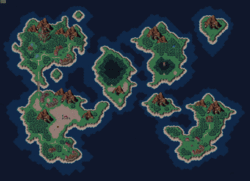Guardia: Difference between revisions
m (→Gallery) |
m (→Government) |
||
| Line 51: | Line 51: | ||
While Marle (also known as Princess Nadia) is the heiress to the throne in [[1000 AD|1000 A.D.]], little is known about how the throne and power exchanges hands. Marle is descended from [[Queen Aliza]], who is descended from [[Leene]]. King Guardia XXXIII is spoken of as the 33rd descendant of the throne. The Kings seem to rule with the most authority. | While Marle (also known as Princess Nadia) is the heiress to the throne in [[1000 AD|1000 A.D.]], little is known about how the throne and power exchanges hands. Marle is descended from [[Queen Aliza]], who is descended from [[Leene]]. King Guardia XXXIII is spoken of as the 33rd descendant of the throne. The Kings seem to rule with the most authority. | ||
[[File:Guardia Crest.png|thumb|left|200px|Guardia's Royal Crest]]Usually, males marry into the family. An exception was made when [[Queen Leene]] married [[King Guardia XXI]], as a female heir may not have been available. The line proceeded with males marrying in all the way to Marle, who married Crono (and by extension he became a regent). This system is evidenced elsewhere in the game. When [[King Zeal]] dies, Janus does not by default become King; rather, [[Queen Zeal]] remains in her position, not as dowager but as dignified ruler. (Note that this is mainly a coincidence) Sexism is also seemingly absent, as even [[Ayla]] was able to be chieftess in [[Prehistory]] due to her strength and merit. The Kingdom may be matrilineal but patriarchal. This possibility is wounded slightly by the fact that [[King Guardia XXXIII]] is referenced as the 33rd descendant of the throne; this simply may be a turn of phrase, however. | [[File:Guardia Crest.png|thumb|left|200px|Guardia's Royal Crest]]Usually, males marry into the family. An exception was made when [[Queen Leene]] married [[King Guardia XXI]], as a female heir may not have been available. The line proceeded with males marrying in all the way to Marle, who married Crono (and by extension he became a regent). This system is evidenced elsewhere in the game. When [[King Zeal]] dies, Janus does not by default become King; rather, [[Queen Zeal]] remains in her position, not as dowager but as dignified ruler. (Note that this is mainly a coincidence) Sexism is also seemingly absent, as even [[Ayla]] was able to be chieftess in [[Prehistory]] due to her strength and merit and was willing to hand her office to Kino, her mate, in the event that she was unfit to reign, either due to death, terminal illness, or pregnancy. The Kingdom may be matrilineal but patriarchal. This possibility is wounded slightly by the fact that [[King Guardia XXXIII]] is referenced as the 33rd descendant of the throne; this simply may be a turn of phrase, however. | ||
[[File:Guardia.png|thumb|180px|King Guardia XXI and Queen Leene in the Throne Room]]Under the idea that males traditionally inherit the throne, the son or daughter of [[King Guardia XXI]] and Queen Leene would have eventually produced [[Queen Aliza]], who would have had to marry back into the family (barring outright incest). This is fine, as twelve generations would have separated their genetics. This idea is supported by the fact that King Guardia XXI is definitely large and in charge during [[600 A.D.]] The royal family may also be extensive enough to allow varied descendants of Leene to exist. | [[File:Guardia.png|thumb|180px|King Guardia XXI and Queen Leene in the Throne Room]]Under the idea that males traditionally inherit the throne, the son or daughter of [[King Guardia XXI]] and Queen Leene would have eventually produced [[Queen Aliza]], who would have had to marry back into the family (barring outright incest). This is fine, as twelve generations would have separated their genetics. This idea is supported by the fact that King Guardia XXI is definitely large and in charge during [[600 A.D.]] The royal family may also be extensive enough to allow varied descendants of Leene to exist. | ||
Revision as of 13:53, 10 June 2011
- For the geographic area, see West Continent.
| Kingdom of Guardia | |
|---|---|
 The Kingdom of Guardia in 600 AD | |
| Time Period | 600 AD |
| Notable inhabitants | Nadia
King Guardia XXXIII |
The Kingdom of Guardia is the primary human kingdom in the world of Chrono Trigger. It was founded in the first year of the new calendar, signified by the acronym AD. The ancestry of Guardia most likely traces its origin from the Kingdom of Zeal of the Antiquity era.
Important Dates
In either 0 or 1 AD (depending on whether Chrono Trigger 's calendar follows the same conventions as ours), the first year of the new calendar, Guardia was founded, proven by the Millennial Fair which takes place every year and celebrates the founding of the nation. It is unclear whether the calendar is actually based off of the founding of Guardia, or if another important event occurred the same year.
From 580-600 AD, the Kingdom was embroiled in a battle against the race known as Fiends and their master, Magus, who sought the extermination of mankind. In 600 AD, Queen Leene was kidnapped by covert Fiend operatives led by the beast Yakra operating out of the land of Guardia. Later that year, a group assaulted the Fiendlord's Keep and destroyed it, ending the war.
In 984, Princess Nadia, daughter of King Guardia XXXIII, was born.
In 1000 AD, the Kingdom of Guardia celebrated its first 1000 years by holding a Millennial Fair in Leene Square. King Guardia XXXIII was put on trial by a descendant of Yakra, Yakra XIII, impersonating the chancellor, and was very nearly executed.
In 1005 AD, in the events of Chrono Cross, Guardia is invaded by the armies of Porre and destroyed (probably because of Dalton) . It is unknown whether the nation was still ruled by King Guardia XXXIII at this time, or if he had already been succeeded by Crono, who married Princess Nadia.
Captial, Cities, and Geography

Truce is the capital of Guardia due to it's close proximity to Guardia Castle and its large population. Between 600 A.D. and 1999 A.D. it remains the major city of Guardia, but due to it's prominence in the Middle Ages, likely its place as capital has a much older origin. The city was likely named Truce due to the peace between Enlightened Ones and Earthbound Ones that survived the Fall of Zeal. Truce is located on the West Continent. Porre, another major city, sits on the southmost tip of the Southern Continent, linked to the West via Zenan Bridge. To the East, and separated by miles of sea, lie Choras and Medina. Both are relatively insignificant, although interestingly enough, Medina is the only city occupied fully by non-humans.
These cities dismantled or were destroyed during the Apocalypse, but their continental locations, although shifted by geothermal or tectonic activity, remain relatively similar to previous eras. Many newer buildings and ruins exist in locations where these cities might have been.

Millions of years in the past, the continent was pangeaic and separated sometime between Prehistory and Antiquity to form the continents. Massive volcanic subduction and glaciers from the coming Ice Age likely sculpted the many mountains and caves present in Modern Guradia. Locations once lost resurfaced in the Future, solidifying this theory. The Sun Palace is one example of this.
Vegetation also forested the continents again, until destroyed by Lavos. Later, it was re-corrected by the time-travelers.
Currency
Through most eras, the standard unit of currency in Guardia is Gold, represented by the letter G (usually capital). In Prehistory, gold is accepted by minor apothecaries, but the merchant in Ioka Village Hut accepts Petals, Fangs, Horns, and Feathers as currency. In the Future, the authenticity and value of gold coins is questioned by the merchants, but are never turned down. Silver Points, a special brand of currency, is only obtainable and spendable in Leene Square.
Religion
Although a Cathedral exists in the Middle Ages, there is no evidence or reference to god(s) within. No paintings, sculptures, or edifices praise any celestial being anywhere in time. The only mention of deity stems from Robo, a sentient machine, who ponders the meaning of life and the seemingly intentional stream of events braided into the lives of inhabitants of Guardia while reforesting the Southern Continent for four hundred years. Sophisticated as this idea seems, the being is only named "Entity". Little else is known about it and little proof is given to its existence and role in the lives of Guardians.
Government

Guardia is ruled by monarchs and their successors; Guardia Castle is their seat. Surrounding cities are governed by Mayors (also called Elders) who maintain fiefs for the crown.
A judicial system was introduced some time between 600 A.D. and 1000 A.D. at the suggestion of the Chancellor; Queen Leene was kidnapped by Yakra, who impersonated a royal official, and stricter government was needed. After rescuing Leene and Marle, Crono is put on trial in the Present, represented by lawyer Pierre, in the very system his actions inspired. Ironically, whether the court finds him guilty or innocent of kidnapping Marle, he is thrown in prison, pending execution. This suggests that while democracy blossoms in Guardia, there are still faults, as noblemen refuse to relinquish their power.
While Marle (also known as Princess Nadia) is the heiress to the throne in 1000 A.D., little is known about how the throne and power exchanges hands. Marle is descended from Queen Aliza, who is descended from Leene. King Guardia XXXIII is spoken of as the 33rd descendant of the throne. The Kings seem to rule with the most authority.

Usually, males marry into the family. An exception was made when Queen Leene married King Guardia XXI, as a female heir may not have been available. The line proceeded with males marrying in all the way to Marle, who married Crono (and by extension he became a regent). This system is evidenced elsewhere in the game. When King Zeal dies, Janus does not by default become King; rather, Queen Zeal remains in her position, not as dowager but as dignified ruler. (Note that this is mainly a coincidence) Sexism is also seemingly absent, as even Ayla was able to be chieftess in Prehistory due to her strength and merit and was willing to hand her office to Kino, her mate, in the event that she was unfit to reign, either due to death, terminal illness, or pregnancy. The Kingdom may be matrilineal but patriarchal. This possibility is wounded slightly by the fact that King Guardia XXXIII is referenced as the 33rd descendant of the throne; this simply may be a turn of phrase, however.

Under the idea that males traditionally inherit the throne, the son or daughter of King Guardia XXI and Queen Leene would have eventually produced Queen Aliza, who would have had to marry back into the family (barring outright incest). This is fine, as twelve generations would have separated their genetics. This idea is supported by the fact that King Guardia XXI is definitely large and in charge during 600 A.D. The royal family may also be extensive enough to allow varied descendants of Leene to exist.
Etymology
Guardia is a Spanish noun for guard, defense, on the watch. On guard is a common phrase, in Spanish "en guardia".




